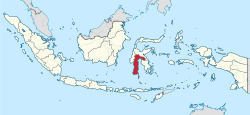
Back Sulawèsi Seulatan ACE سولاوسي الجنوبية Arabic Célebes Meridional AST گونئی سولاوسی AZB Sulawesi Selatan BAN Паўднёвы Сулавесі Byelorussian Sulawési Kidul BEW Южно Сулавеси Bulgarian Sulawesi Selatan BTM Nàng Sulawesi CDO
South Sulawesi
Sulawesi Selatan | |
|---|---|
| Province of South Sulawesi Provinsi Sulawesi Selatan | |
| Motto(s): | |
 | |
| Coordinates: 3°45′S 120°0′E / 3.750°S 120.000°E | |
| Founded | 13 December 1960 |
| Capital and largest city | Makassar |
| Government | |
| • Body | South Sulawesi Provincial Government |
| • Governor | Fadjry Djufry (acting) |
| • Vice Governor | Vacant |
| Area | |
• Total | 45,330.55 km2 (17,502.22 sq mi) |
| • Rank | 16th |
| Highest elevation | 3,478 m (11,411 ft) |
| Population (mid 2023 Estimate)[1] | |
• Total | 9,362,290 |
| • Density | 210/km2 (530/sq mi) |
| Demographics | |
| • Ethnic groups[2] | 45.12% Buginese 29.68% Makassarese 7.34% Torajan 4.93% Luwu 2.86% Javanese 2.8% Duri 6.3% other |
| • Religion[3] | 89.78% Islam 7.64% Protestantism 1.55% Catholicism 0.73% Hinduism 0.25% Buddhism 0.06% Confucianism and other |
| • Languages | Indonesian (official) Makassar Malay (lingua franca, casual) Buginese, Makassarese, Luwu, Toraja (regional) |
| Time zone | UTC+08 (Indonesia Central Time) |
| ISO 3166 code | ID-SN |
| GDP (nominal) | 2022[4] |
| - Total | Rp 605.2 trillion (9th) US$ 40.8 billion Int$ 124.3 billion (PPP) |
| - Per capita | Rp 65.6 million (12th) US$ 4,417 Int$ 13,784 (PPP) |
| - Growth | |
| HDI (2024) | |
| Website | sulselprov.go.id |
South Sulawesi (Indonesian: Sulawesi Selatan) is a province in the southern peninsula of Sulawesi, Indonesia. The Selayar Islands archipelago to the south of Sulawesi is also part of the province. The capital and largest city is Makassar. The province is bordered by Central Sulawesi and West Sulawesi to the north, the Gulf of Bone and Southeast Sulawesi to the east, Makassar Strait to the west, and Flores Sea to the south.
The 2010 census estimated the population as 8,032,551,[7] which makes South Sulawesi the most populous province on the island (46% of the population of Sulawesi is in South Sulawesi), and the sixth most populous province in Indonesia. At the 2020 Census, this had risen to 9,073,509,[8] and the official estimate as of mid-2023 was 9,362,290 (comprising 4,651,180 males and 4,711,110 females).[1] The main ethnic groups in South Sulawesi are the Buginese, Makassarese and Torajan. The economy of the province is based on agriculture, fishing, and the mining of gold, magnesium, iron, and other metals. The pinisi, a traditional Indonesian two-masted sailing ship, is still used widely by the Buginese and Makassarese, mostly for inter-insular transportation, cargo, and fishing purposes within the Indonesian archipelago.
During the golden era of the spice trade, from the 15th to 19th centuries, South Sulawesi served as the gateway to the Maluku Islands. There were several small kingdoms, including two prominent ones, the kingdom of Makassar and the Bugis kingdom Bone. The Dutch East India Company (VOC) began operating in the region in the 17th century. VOC later allied with the Bugis prince, Arung Palakka, and they defeated the kingdom of Makassar. The king of Makassar, Sultan Hasanuddin was forced to sign a treaty that greatly reduced the power of Bungaya Gowa.
- ^ a b Badan Pusat Statistik, Jakarta, 28 February 2024, Provinsi Sulawesi Selatan Dalam Angka 2024 (Katalog-BPS 1102001.73)
- ^ Ananta et al. 2015, pp. 119–122.
- ^ Ananta et al. 2015, p. 263.
- ^ Badan Pusat Statistik (2023). "Produk Domestik Regional Bruto (Milyar Rupiah), 2020–2022" (in Indonesian). Jakarta: Badan Pusat Statistik. Archived from the original on 2022-11-25. Retrieved 2023-09-03.
- ^ Badan Pembangunan Nasional (2023). "Capaian Indikator Utama Pembangunan" (in Indonesian). Jakarta: Badan Pembangunan Nasional. Archived from the original on 2023-09-03. Retrieved 2023-09-03.
- ^ "Indeks Pembangunan Manusia 2024" (in Indonesian). Statistics Indonesia. 2024. Retrieved 15 November 2024.
- ^ Biro Pusat Statistik, Jakarta, 2011.
- ^ Badan Pusat Statistik, Jakarta, 2021.

